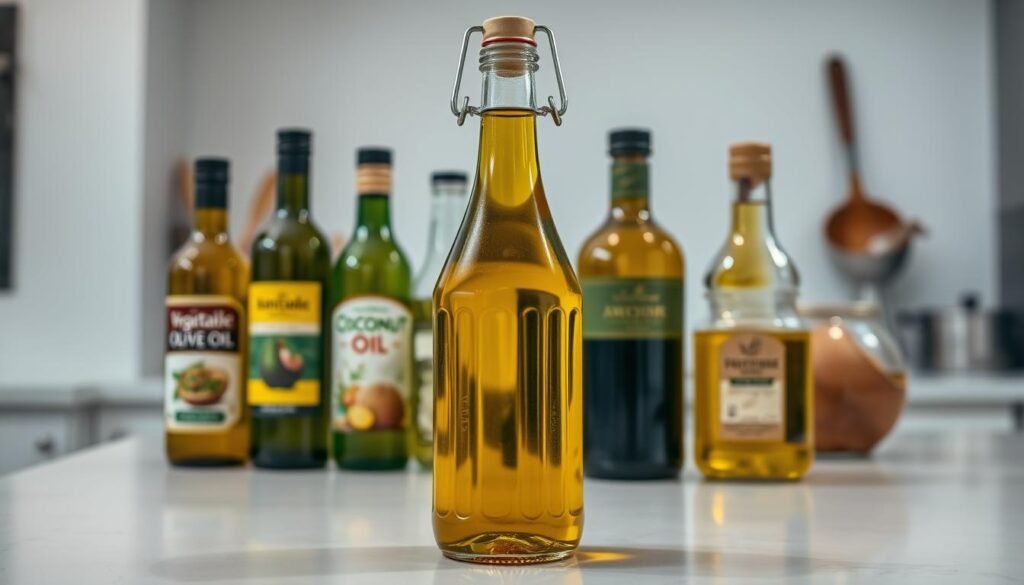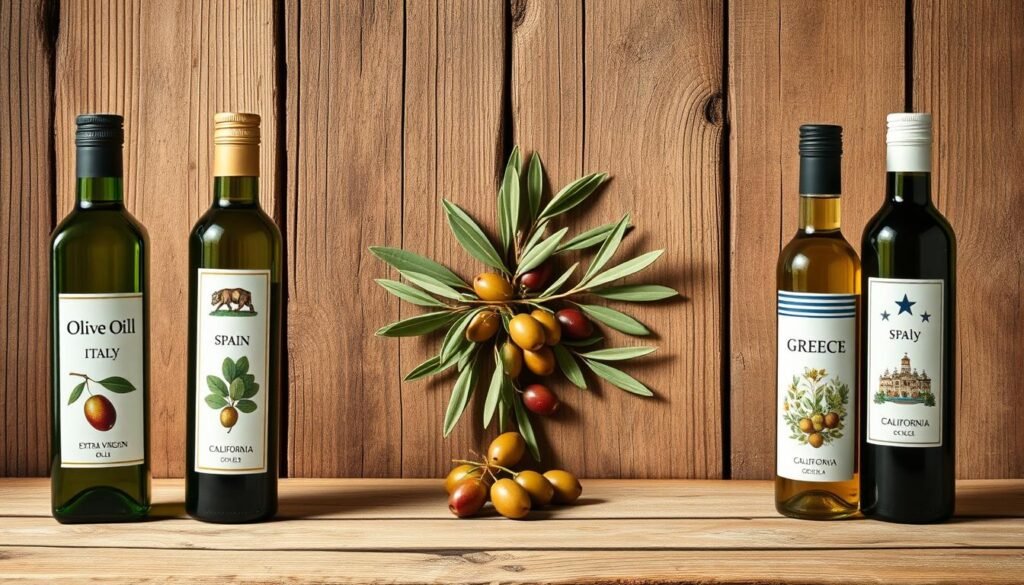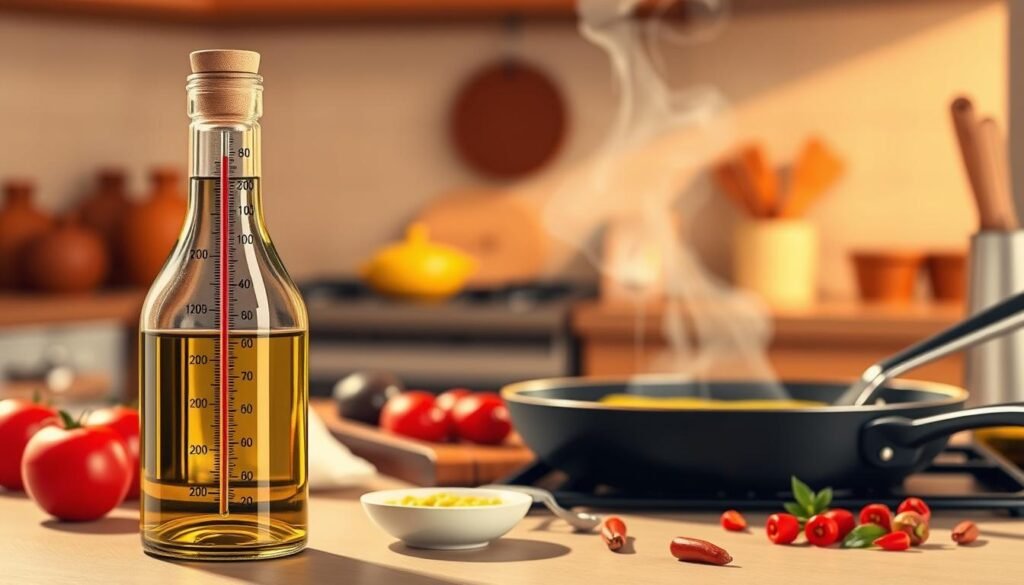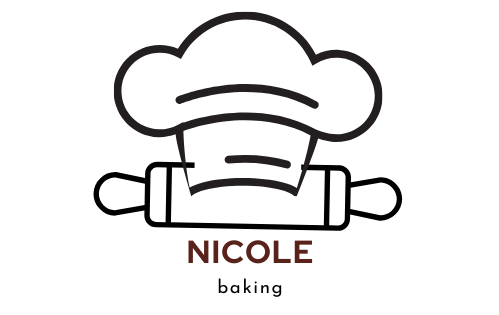
Most home cooks keep this liquid gold in their pantry, but few realize its full potential. While salad dressings and sautéing get all the attention, there’s a world of unexpected applications waiting to be discovered. We’re about to reveal how this ancient ingredient can solve modern kitchen challenges.
Chefs worldwide use it to create velvety sauces, tender baked goods, and even showstopping desserts. The secret lies in understanding different varieties – from peppery extra virgin to neutral refined versions. Each type brings unique qualities to heat-based techniques and finishing touches.
Our guide goes beyond basic substitutions. You’ll learn professional methods for enhancing flavors while boosting nutritional value. Discover how its chemical properties make it ideal for everything from high-heat frying to delicate emulsifications.
We’ve packed this article with actionable tips you can try tonight. Whether you’re making pasta, pastries, or pantry staples, you’ll find clever ways to elevate your meals. Get ready to rethink every bottle in your kitchen.
- 【 The Highest Quality Cold-Pressed Moroccan Olive Oil】 The Atlas Mountains of Morocco help grow the most perfect olives …
- 【 Maximum Health Benefits with Only Single Pressing of the Olives】 The Atlas Mountains of Morocco help grow the most per…
- 【 You will love the delicately complex aroma 】 that takes in almonds, culinary herbs and a mix of sweet bananas, lemons …
Introduction to Our Buyer’s Guide on Olive Olive Oil
The difference between a good meal and a great one often starts with your selection. Grocery shelves overflow with options, but not all products deliver equal results. Our guide cuts through the noise to help you spot authentic quality without second-guessing labels.
Extra-virgin varieties stand apart because they’re cold-pressed and chemical-free. This preservation method locks in robust flavors and nutrients. However, even within this category, taste and texture vary widely based on harvest timing and regional growing conditions.
We’ve identified three non-negotiable criteria for choosing reliable products:
- Harvest dates within 12 months
- Dark glass bottles for light protection
- Third-party certification seals
| Grade | Processing Method | Best For | Quality Markers |
|---|---|---|---|
| Extra Virgin | Cold extraction | Dressings, dipping | Peppery finish, fruity aroma |
| Virgin | Mechanical pressing | Medium-heat cooking | Mild acidity |
| Refined | Filtered & processed | High-heat frying | Neutral taste |
Price doesn’t always indicate value – some budget-friendly bottles outperform luxury brands in blind tastings. We’ll show you how to decode packaging claims and avoid diluted blends masquerading as premium options.
Understanding Olive Olive Oil: Quality and Label Differences
Ever grabbed a bottle just to find its flavor doesn’t match its price tag? Many shoppers face this frustration due to confusing terminology. Let’s cut through the jargon to help you spot true quality.
Decoding Extra Virgin Versus Light Options
Extra virgin olive oil (EVOO) isn’t just a label – it’s a guarantee. To earn this title, producers must meet strict standards: less than 0.8% acidity and zero flavor defects. Unlike refined “light” versions, EVOO retains natural antioxidants and peppery notes.
Light varieties undergo intense processing that strips away both taste and nutrients. Despite the name, they contain the same calories as regular options. These neutral oils work best for high-heat cooking where flavor doesn’t matter.
How to Read and Interpret the Label
Three elements separate premium products from imitations:
- Harvest dates within the last 12 months
- Certification seals from groups like the IOC or NAOOA
- Single-origin claims naming specific regions
| Type | Processing | Acidity | Best Uses |
|---|---|---|---|
| Extra Virgin | Cold-pressed | <0.8% | Drizzling, dips |
| Virgin | Mechanical extraction | <2% | Low-heat sautéing |
| Light | Refined & filtered | N/A | Deep frying |
Dark glass bottles and “first cold press” statements signal careful production. Avoid anything labeled “pure” – this often means blended with lower-grade oils.
History and Cultural Significance of Olive Olive Oil
Long before it graced modern kitchens, this golden liquid shaped civilizations. Neolithic people first harnessed wild fruits around 10,000 years ago, pressing them into rudimentary extracts. These early methods laid the foundation for a staple that would fuel empires.
Ancient Mediterranean cultures transformed simple pressed extract into currency and sacrament. Greek athletes rubbed it on their skin, while Roman legions used it as wages. Temples burned lamps filled with the precious fluid, linking earthly rituals to divine realms.
Three key developments defined its enduring legacy:
- Phoenician traders spread cultivation techniques across coastal regions
- Roman engineering perfected screw presses for mass production
- Religious texts adopted it as a symbol of purity and healing
| Era | Role | Cultural Impact |
|---|---|---|
| Neolithic | Food & Medicine | Early trade networks |
| Ancient Greece | Olympic rituals | Symbol of victory |
| Roman Empire | Economic currency | Standardized production |
| Middle Ages | Religious rites | Sacred ceremonies |
Through centuries of innovation, Mediterranean communities developed distinct pressing styles. Southern regions favored fruitier profiles, while North African methods yielded spicier notes. These traditions still influence today’s artisanal practices.
Diplomats now exchange olive branches as peace offerings, continuing a 3,000-year-old tradition. From ancient amphorae to modern bottles, this versatile substance remains humanity’s oldest companion in both nourishment and symbolism.
- SMOOTH EXTRA VIRGIN OLIVE OIL: Expertly crafted by The Olive Oil People, this extra virgin olive oil is made from first …
- SMOOTH, DELICATE TASTE: Pompeian Extra Virgin Olive Oils are ideal for any meal that starts with a sauté and ends with a…
- 100% FARMER CRAFTED: Quality from The Olive Oil People since 1906.
The Journey from Orchard to Bottle
From ancient groves to your kitchen shelf, the transformation of bitter fruits into smooth liquid involves precise steps. Timing matters most – early harvests deliver peppery zing, while late picks create mellow finishes. Let’s explore how centuries-old techniques blend with cutting-edge innovation.
Traditional Versus Modern Extraction Methods
Stone mills dominated for millennia, crushing whole fruits into paste over hours. This slow method preserves delicate aromas but yields less liquid. Joseph Graham’s 1795 hydraulic press revolutionized efficiency, squeezing paste through stacked mats to separate liquid gold.
Today’s stainless steel grinders pulverize pits and flesh in seconds. Faster processing prevents oxidation but generates heat that alters flavor profiles. Cold mechanical pressing remains key for premium grades – no chemicals, just physics.
The Role of Technology in Production
Malaxation tanks now control temperature during mixing, coaxing oil droplets to merge without losing nutrients. Centrifuges spin mixtures at 3,000 RPM, replacing days of gravity separation with minutes of precision.
Filtration debates divide producers. Unfiltered versions retain antioxidants but cloud faster. Clear bottles benefit from microfiltration’s stability boost, though some polyphenols get stripped. Your preference determines which trade-off wins.
Nutritional Benefits and Health Impact of Olive Olive Oil
While many focus on its culinary uses, this golden liquid packs a nutritional punch few ingredients match. At its core, it’s 100% fat – but not all fats are created equal. Over 80% comes from monounsaturated oleic acid, a heart-healthy compound shown to balance cholesterol levels in clinical studies.
Here’s what makes it stand out:
- Rich antioxidant content: Extra virgin varieties contain vitamin E and polyphenols that combat cellular damage
- Smart calorie management: At 120 calories per tablespoon, controlled portions enhance meals without derailing diets
- Anti-inflammatory properties: Regular consumption may reduce joint pain and chronic disease risks
| Fatty Acid | Percentage | Health Benefit |
|---|---|---|
| Oleic Acid | 55-83% | Supports HDL cholesterol |
| Linoleic Acid | 3.5-21% | Skin and brain health |
| Palmitic Acid | 7.5-20% | Energy production |
Research links Mediterranean diets rich in virgin olive varieties to 30% lower cardiovascular risks. The secret? Cold-pressed versions retain 30% more antioxidants than refined options. These compounds help neutralize free radicals linked to aging and disease.
For maximum benefits, drizzle EVOO over finished dishes rather than cooking it at high heat. Pair it with colorful vegetables – the fat boosts nutrient absorption from plant foods. Remember: quality matters more than quantity when harnessing its full health potential.

How We Select the Best Olive Olive Oil
Navigating supermarket aisles reveals countless options, but genuine quality hides in plain sight. Our team evaluates hundreds of products annually using strict criteria developed through industry partnerships. Authenticity begins with transparency – trustworthy producers proudly share their sourcing details.
Decoding Geographic Authenticity
Country codes tell the real story. Look for capital letter combinations near the barcode: IT indicates Italian-grown olives, GR for Greek. Many companies use “Bottled in Italy” labels while using cheaper imports – a legal loophole we actively flag.
Three markers separate premium options:
- Harvest dates within 24 months
- Specific growing regions like Sicily or Crete
- Third-party certifications (PDO/PGI)
| Code | Country | Common Regions |
|---|---|---|
| IT | Italy | Tuscany, Liguria |
| GR | Greece | Kalamata, Crete |
| ES | Spain | Andalusia, Catalonia |
Price often reveals blended imposters. True single-origin products cost more due to stricter production standards. Trust bottles listing cooperative names over vague “Product of Europe” claims.
We conduct blind taste tests assessing peppery finishes and fruity aromas – hallmarks of proper handling. Cloudy appearance? That’s actually good – it signals unfiltered nutrients. Armed with these insights, you’ll spot quality faster than most store managers.
Olive Olive Oil in Salad Dressings and Marinades
Your dressing bowl holds more potential than you think. With the right techniques, everyday greens become vibrant canvases for flavor exploration. The key lies in pairing ingredients that amplify rather than compete.
Balance makes brilliance. For every three parts EVOO, use one part acid – but don’t stop at balsamic. Try sherry vinegar for nutty salads or yuzu juice with seafood dishes. Whisk vigorously to create stable emulsions that cling to leaves without separating.
Match oil intensity to your base ingredients:
| Salad Type | Oil Profile | Pairing Tip |
|---|---|---|
| Kale & Radicchio | Peppery, bold | Add Dijon & garlic |
| Butter Lettuce | Mellow, buttery | Combine with lemon zest |
| Fruit Salads | Fruity, light | Mix with honey & mint |
Marinades benefit from EVOO’s dual role. Its fats carry flavors deep into proteins while enzymes naturally tenderize. For chicken, blend with rosemary and citrus. Fish thrives with dill and cracked pepper infusions.
Pro tip: Always add salt after emulsifying. This prevents breaking and ensures even distribution. Transform your next meal by letting quality ingredients shine through thoughtful combinations.
Cooking with Olive Olive Oil: Sautéing, Frying, and More
Mastering heat control transforms this kitchen staple from basic to brilliant. Different varieties perform uniquely under temperature stress, making technique selection crucial for preserving flavor and nutrition.

Understanding Smoke Points and Heat Levels
Extra virgin options tolerate 356-419°F – perfect for most stovetop tasks. Premium cold-pressed versions often handle higher temps than mass-produced counterparts due to lower acidity. Refined types reach 446°F, ideal for searing meats or stir-frying.
| Type | Smoke Point | Best Uses |
|---|---|---|
| Extra Virgin | 356-419°F | Sautéing, roasting |
| Refined | Up to 446°F | Deep frying, searing |
Watch for shimmering surfaces and faint wisps – these visual cues indicate optimal heating. Combine varieties strategically: use neutral refined types for cooking, then finish dishes with peppery EVOO drizzle.
Common errors include reusing oil multiple times or storing near heat sources. Proper technique preserves antioxidants while creating complex flavor layers in every dish.
Innovative Ways to Incorporate Olive Olive Oil Into Daily Meals
Transform ordinary ingredients into extraordinary dishes with simple tweaks. Swap butter for a drizzle of olive oil on morning toast topped with ripe tomatoes. Mix it into pancake batter for fluffier results, or blend with herbs for vibrant pasta tosses.
Summer meals shine when you infuse grilled vegetables with lemon-infused oil. Try an Italian-inspired trick: toss roasted potatoes with rosemary while warm. For quick recipes, whisk it into smoothies or drizzle over fresh fruit salads.
Quality matters most. Seek small-batch producers using sustainable methods. Their care translates into richer flavors that elevate every meal. Discover new ways to make this ancient ingredient your modern kitchen ally.
FAQ
What defines the quality differences between extra virgin and light varieties?
We categorize extra virgin olive oil (EVOO) by its cold-pressed extraction, zero chemical refining, and flawless taste. Light versions undergo processing that reduces flavor intensity and raises smoke points, making them better for high-heat cooking.
How do we verify the country of origin listed on labels?
We check for specific region details, harvest dates, and certifications like PDO/PGI. Authentic producers often include traceability codes or estate names, ensuring transparency from orchard to bottle.
Why does smoke point matter when sautéing or frying?
Heating oil beyond its smoke point breaks down nutrients and creates bitter flavors. We prioritize oils with higher smoke points (like refined blends) for frying, while reserving EVOO for low-heat dishes or finishing.
Can EVOO lose its health benefits over time?
Yes. Exposure to light, heat, or air degrades antioxidants like polyphenols. We recommend storing it in dark glass bottles, using it within 18 months, and avoiding clear containers or warm storage areas.
What makes certain oils better for salad dressings?
Fresh, peppery EVOOs with vibrant fruitiness enhance raw dishes. We look for balanced acidity (under 0.8%) and tasting notes like grass or almond that complement greens without overpowering them.
How do traditional stone mills differ from modern extraction?
Stone milling preserves delicate aromas but yields less oil. Centrifugal systems used today speed up separation while maintaining quality, ensuring higher efficiency without sacrificing flavor integrity.


